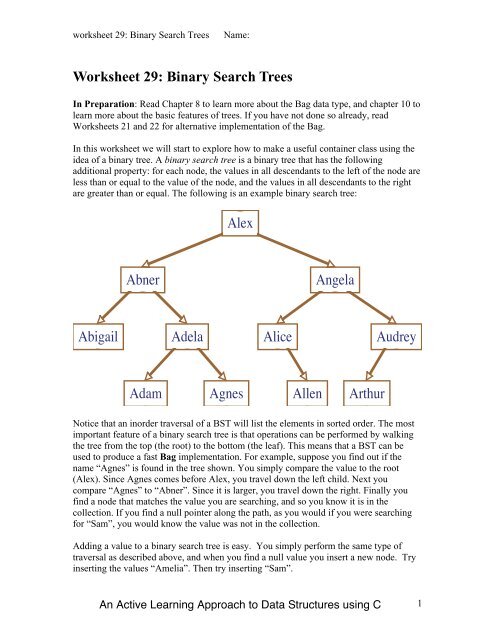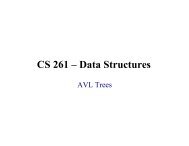Worksheet 29 - Classes
Worksheet 29 - Classes
Worksheet 29 - Classes
You also want an ePaper? Increase the reach of your titles
YUMPU automatically turns print PDFs into web optimized ePapers that Google loves.
worksheet <strong>29</strong>: Binary Search Trees<br />
Name:<br />
<strong>Worksheet</strong> <strong>29</strong>: Binary Search Trees<br />
In Preparation: Read Chapter 8 to learn more about the Bag data type, and chapter 10 to<br />
learn more about the basic features of trees. If you have not done so already, read<br />
<strong>Worksheet</strong>s 21 and 22 for alternative implementation of the Bag.<br />
In this worksheet we will start to explore how to make a useful container class using the<br />
idea of a binary tree. A binary search tree is a binary tree that has the following<br />
additional property: for each node, the values in all descendants to the left of the node are<br />
less than or equal to the value of the node, and the values in all descendants to the right<br />
are greater than or equal. The following is an example binary search tree:<br />
Alex<br />
Abner<br />
Angela<br />
Abigail<br />
Adela Alice Audrey<br />
Adam Agnes Allen Arthur<br />
Notice that an inorder traversal of a BST will list the elements in sorted order. The most<br />
important feature of a binary search tree is that operations can be performed by walking<br />
the tree from the top (the root) to the bottom (the leaf). This means that a BST can be<br />
used to produce a fast Bag implementation. For example, suppose you find out if the<br />
name “Agnes” is found in the tree shown. You simply compare the value to the root<br />
(Alex). Since Agnes comes before Alex, you travel down the left child. Next you<br />
compare “Agnes” to “Abner”. Since it is larger, you travel down the right. Finally you<br />
find a node that matches the value you are searching, and so you know it is in the<br />
collection. If you find a null pointer along the path, as you would if you were searching<br />
for “Sam”, you would know the value was not in the collection.<br />
Adding a value to a binary search tree is easy. You simply perform the same type of<br />
traversal as described above, and when you find a null value you insert a new node. Try<br />
inserting the values “Amelia”. Then try inserting “Sam”.<br />
An Active Learning Approach to Data Structures using C 1
worksheet <strong>29</strong>: Binary Search Trees<br />
Name:<br />
Insertion is most easily accomplished by writing a private internal function that takes a<br />
Node and a value, and returns the new tree in which the Node has been inserted. In<br />
pseudo-code this routine is similar to the following:<br />
Node add (Node start, E newValue)<br />
if start is null then return a new Node with newValue<br />
otherwise if newValue is less than the value at start then<br />
set the left child to be the value returned by add(leftChild, newValue)<br />
otherwise set the right child to be add(rightChild, newValue)<br />
return the current node<br />
Removal is the most complex of the basic Bag operations. The difficulty is that removing<br />
a node leaves a “hole”. Imagine, for example, removing the value “Alex” from the tree<br />
shown. What value should be used in place of the removed element?<br />
The answer is the leftmost child of the right node. This is because it is this value that is<br />
the smallest element in the right subtree. The leftmost child of a node is the value found<br />
by running through left child Nodes as far as possible. The leftmost child of the original<br />
tree shown above is “Abigail”. The leftmost child of the right child of the node “Alex” is<br />
the node “Alice”. It is a simple matter to write a routine to find the value of the leftmost<br />
child of a node. You should verify that in each case if you remove an element the value<br />
of the node can be replaced by the leftmost child of the right node without destroying the<br />
BST property.<br />
A companion routine (removeLeftmost) is a function to return a tree with the leftmost<br />
child removed. Again, traverse the tree until the leftmost child is found. When found,<br />
return the right child (which could possibly be null). Otherwise make a recursive call and<br />
set the left child to the value returned by the recursive call, and return the current Node.<br />
Armed with these two routines, the general remove operation can be described as<br />
follows. Again it makes sense to write it as a recursive routine that returns the new tree<br />
with the value removed.<br />
Node remove (Node start, E testValue)<br />
if start.value is the value we seek<br />
decrease the value of dataSize<br />
if right child is null<br />
return left child<br />
otherwise<br />
replace value of node with leftmost child of right child<br />
set right child to be removeLeftmost(right child)<br />
otherwise if testValue is smaller than start.value<br />
set left child to remove (left child, testValue)<br />
otherwise<br />
set right child to remove (right child, testValue)<br />
return current node<br />
An Active Learning Approach to Data Structures using C 2
worksheet <strong>29</strong>: Binary Search Trees<br />
Name:<br />
Try executing this function on each of the values of the original binary search tree in turn,<br />
and verifying that the result is a valid binary search tree.<br />
Using the approach described, complete the following implementation:<br />
struct node {<br />
TYPE value;<br />
struct node * left;<br />
struct node * right;<br />
};<br />
struct BinarySearchTree {<br />
struct node *root;<br />
int size;<br />
};<br />
void BSTinit(struct BinarySearchTree *tree) { tree->size = 0; tree->root = 0: }<br />
void BSTadd(struct BinarySearchTree *tree, TYPE newValue) {<br />
tree->root = BSTnodeAdd(tree->root, newValue); tree->size++; }<br />
int BSTsize (struct binarySearchTree *tree) { return tree->size; }<br />
struct node * BSTnodeAdd (struct node *current, TYPE newValue) {<br />
}<br />
An Active Learning Approach to Data Structures using C 3
worksheet <strong>29</strong>: Binary Search Trees<br />
Name:<br />
int BSTcontains (struct binarySearchTree *tree, TYPE d) {<br />
}<br />
void BSTremove (struct binarySearchTree *tree, TYPE d) {<br />
if (BSTcontains(tree, d) {<br />
tree->root = BSTnodeRemove(tree->root, d);<br />
tree->size--;<br />
}<br />
}<br />
TYPE leftMostChild (struct node * current) {<br />
}<br />
An Active Learning Approach to Data Structures using C 4
worksheet <strong>29</strong>: Binary Search Trees<br />
Name:<br />
struct node * removeLeftmostChild (struct node *current) {<br />
}<br />
void BSTnodeRemove (struct node * current, TYPE d) {<br />
}<br />
An Active Learning Approach to Data Structures using C 5
worksheet <strong>29</strong>: Binary Search Trees<br />
Name:<br />
On Your Own<br />
1. What is the primary characteristic of a binary search tree?<br />
2. Explain how the search for an element in a binary search tree is an example of the<br />
idea of divide and conquer.<br />
3. Try inserting the values 1 to 10 in order into a BST. What is the height of the<br />
resulting tree?<br />
4. Why is it important that a binary search tree remain reasonably balanced? What<br />
can happen if the tree becomes unbalanced?<br />
5. What is the maximum height of a BST that contains 100 elements? What is the<br />
minimum height?<br />
6. Explain why removing a value from a BST is more complicated than insertion.<br />
7. Suppose you want to test our BST algorithms. What would be some good<br />
boundary value test cases?<br />
8. Program a test driver for the BST algorithm and execute the operations using the<br />
test cases identified in the previous question.<br />
9. The smallest element in a binary search tree is always found as the leftmost child<br />
of the root. Write a method getFirst to return this value, and a method removeFirst<br />
to modify the tree so as to remove this value.<br />
10. With the methods described in the previous question, it is easy to create a data<br />
structure that stores values in a BST and implements the Priority Queue interface.<br />
Show this implementation, and describe the algorithmic execution time for each<br />
of the Priority Queue operations.<br />
11. Suppose you wanted to add the equals method to our BST class, where two trees<br />
are considered to be equal if they have the same elements. What is the complexity<br />
of your operation?<br />
An Active Learning Approach to Data Structures using C 6

















